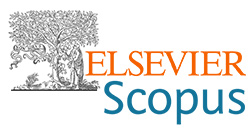Hydrate formation and its influence on natural gas pipeline: Simulation study
DOI:
https://doi.org/10.62638/ZasMat1088Abstract
This study simultaneously studied the twin problem of hydrate and corrosion that occurs in natural gas pipelines, establishing their interdependence using a simulation approach. CO2 corrosion was simulated using the NORSOK M-506 standard model in Matlab. Major factors considered are the relationship between corrosion rate and temperature, corrosion rate and PH, corrosion-temperature relationship for varying CO2 mole percent, and PH values. The result from this study established that both type I and type II hydrates could form at the operating conditions of 5OC and 60 bar. The obtained result also shows that the rate of corrosion decreases and increases with an increase in PH values and temperature respectively to a certain temperature of approximately 78 OC, then a dip in the rate of corrosion. The result for the corrosion-temperature relationship for varying PH values and CO2 mole percent shows a decrease in corrosion rate with an increase in PH and an increase with the increase in CO2 mole percent. Furthermore, the obtained results highlight a rise as high as 5.7 mm/year at a 3 mole percent CO2. This value and trend portray a bad omen for the affected pipeline. This study recommends that natural gas to be transported by pipeline should be sweetened and processed to remove H2S, CO2, and mercaptans if present.
Keywords:
CO2 corrosion, model, simulation, hydrate, MATLABReferences
M. Mohitpour (2008) Energy supply and transportation, ASME Press, New York, p.79 - 88.
https://doi.org/10.1115/1.802724.ch6
S. Mokhatab, W.A. Poe, J.A Speight (2006) Hand book of natural gas transmission and processing. London: Elsevier, p. 117 - 132.
L. Proberezhny, A. Hrysanchuk, H. Grytsuliak (2019) Influence of the gas hydrate on the corrosion rate of gas gathering pipeline. Procedia Structural Integrity. 16, 141 - 147.
https://doi.org/10.1016/j.prostr.2019.07.033
M.H. Abbas, R. Norman, A. Charles (2018) Neural network modeling of high pressure CO2 corrosion in pipeline steels. Process safety and environmental protection H.Q.119, 36 - 40,
https://doi.org/10.1016/j.psep.2018.07.006
L. Zunzhao, L. Shihan, W. Xiaolin, X. Qian, D. Kai, L. Mingrui, Z. Wei, M. Fanfei, F.Shuanshi, L. Xuemei (2020) Study on corrosion of CO2 in pipelines in the presence of hydrate. In: Paper presented at the 30th International Ocean and Polar Engineering Conference, Virtual.
E.O. Obanijesu, V. Pareek, M.O. Tade (2014) Modeling the contribution of gas hydrate to corrosion rate along the subsea pipelines. Petroleum Science and Technology. 32 (21), 2538 - 2548. https://doi.org/10.1080/10916466.2013.842586.
S. Olsen (2003) CO2 corrosion prediction by use of the NORSOK M-506 model guidelines and limitations. In: Paper Presented at corrosion 2003, San Diego, California, 2003.
R. Nyborg (2009) Guidelines for prediction of CO2 corrosion in oil and gas production system. IFE Institute for Energy Technology, Halden Norway, 2 - 13.
S. Nesic, J. Postlethwaite, M. Vrhovic (1997) CO2 corrosion of carbon steel from mechanistic to empirical modeling. Corrosion Reviews.15 (1-2), 211-270, 1997,
https://doi.org/10.1515/CORREV.1997.15.1-2.211.
A. Kahyarian, M. Singer, S. Nesic (2016) Modeling of uniform CO2 corrosion of mild steel in gas transportation systems: a Review. Journal of Natural Gas Science and Engineering. 29,530-549.
https://doi.org/10.1016/j.jngse.2015.12.052
R.C. Wollam, S.E. Hernandez (2006) Assessment and comparison of CO2 corrosion prediction models. In: Paper Presented at SPE International Oilfield Corrosion Symposium, Aberdeen, UK. Society of Petroleum Engineers. https://doi.org/10.2118/100673-MS
S. Nesic, M. Nordsveen, N. Maxwell, M. Vrhovac (2001) Probabilistic modelling of CO2 corrosion laboratory data using neural networks. Corrosion Sci. 43 (9), 1373 - 1392.
https://doi.org/10.1016/S0010-938X(00)00157-8
S. Hatami, A.A. Ghaderi, K.M. Neknyad, M.F. Karimi, M.R. Rasael, A.H. Mohammadi (2016) On the prediction of CO2 corrosion in petroleum industry. Journal of Supercritical Fluids, 117, 108-112, https://doi.org/10.1016/J.Supflu.2016.05.047
R. Nyborg (2002) Overview of CO2 corrosion models for wells and pipelines. In: Paper Presented at the Corrosion 2002, Denver, Colorado, 2002.
C. De Waard, U. Lotz, D.E. Milliams (1991) Predictive model for CO2 corrosion engineering in wet natural gas pipelines. Corrosion. 47 (12), 976 - 985. https://doi.org/10.5006/1.3585212
B.F.M. Pots, S.D. Kapusta, R.C. John, M.J.J. Thomas, I.J. Rippon, T.S Whithan, M. Girgis (2002) Improvement on De-Waard-Milliams corrosion prediction and applications to corrosion management. In: Paper Presented at the Corrosion 2002, Denver, Colorado, 2002.
S. Olsen, A.M. Halversen, P.G. Lunder, R. Nyborg (2005) CO2 prediction model-basic principles. In: Paper Presented at the Corrosion 2005, Houston, Texas, 2005.
G.A. Niklasson, C.G. Granqvist, A. Hjortsberg (2008) Electrochromic and gasochromic devices. Solar energy materials and solar cells. 92 (4), 384 - 394. https://doi.org/10.1016/j.solmat.2007.06.040.
S. Krishnan, M. Natarajan, V. Balasubramanian, N. Rajendran (2008) Flow-assisted corrosion of 2.25Cr-1Mo steel. Materials chemistry and physics. 107(1), 84-89.







